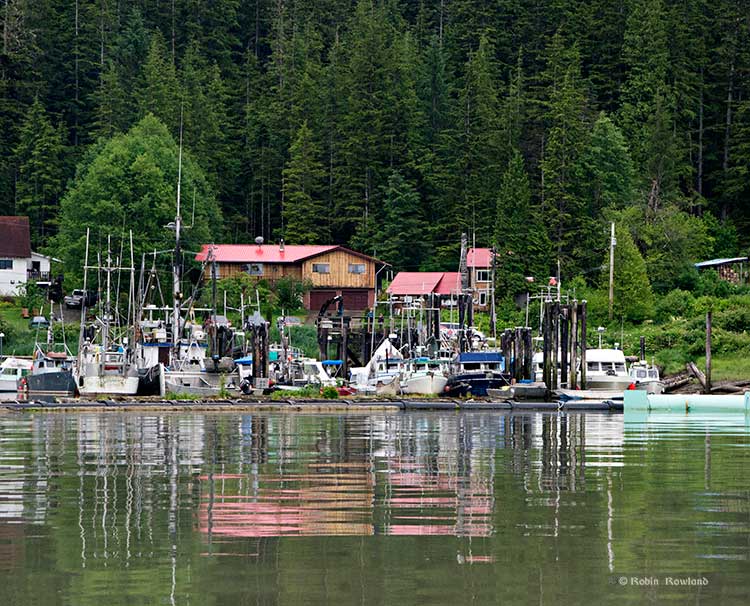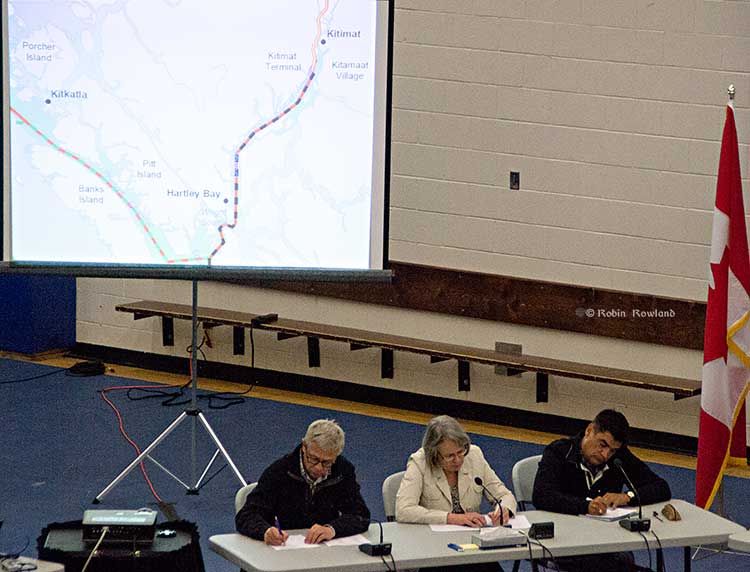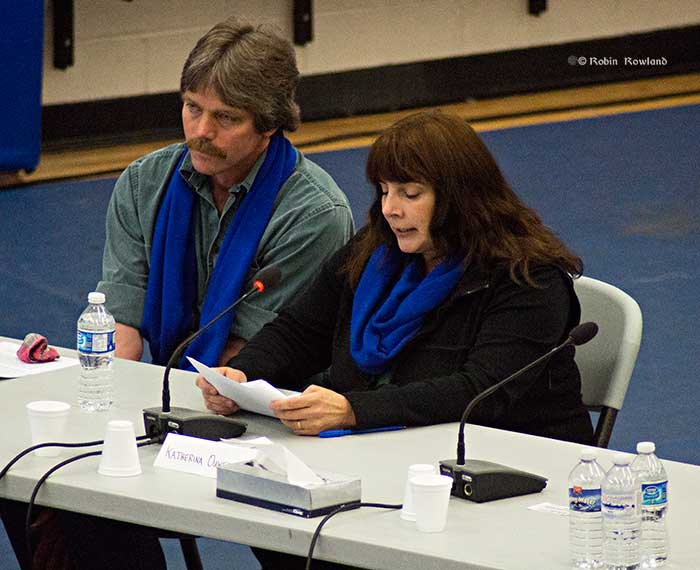
A series of questions filed by Enbridge Northern Gateway with the Joint Review Panel appear to be a “fishing expedition” to find out not only what the Haisla Nation feel about the Northern Gateway project but also seeks details of Haisla agreements with the various Kitimat liquified natural gas projects.
In its May filing, Enbridge asks the Haisla Nation 28 pages of questions, many of them political, and also try to find out the sources of funding the Haisla Nation is using for its participation in the Northern Gateway Joint Review process, questioning the credentials of the experts hired by the Haisla and are likely setting up the First Nation for Enbridge’s propaganda campaigns about current vessel traffic on the Douglas Channel.
( See: The Empire Strikes Back I: Enbridge takes on First Nations, small intervenors )
On May 11, Enbridge filed a series of questions with 24 intervenors and First Nations asking detailed questions not only about the technical issues raised by those groups but also their funding sources and their political actvity.
In its questions to the Haisla Nation, Enbridge asks a series of technical questions around the questions of “acceptable risk” and it appears, despite the fact Enbridge officials have listened to the Haisla official presentation at Kitamaat Village last January (and the speeches of Haisla members this week at the pubic comment hearings) that Enbridge is preparing to use a paper-based or Alberta-based concept of “acceptable risk,” as opposed to listening to the First Nation that will be most directly affected by any disaster in the Kitimat harbour or estuary.
The first questions Enbridge asks the Haisla Nation are blunt, and again, appear to contradict what Enbridge has been saying about First Nations agreeing to back the pipeline.
(a) Please confirm that the Haisla Nation opposes the approval of Northern Gateway’s Application for the Project.(b) If the Haisla Nation opposes the approval of the Application, please advise as to whether there are conditions of approval that would nonetheless address, in whole or in part, the Nation’s concerns.
(c) If so, please elaborate on the nature of any conditions that the Haisla Nation would suggest be imposed on the Project, should it be approved.
(d) Please summarize the effects that the Haisla Nation considers would be created by the Project, should it be approved and constructed. Include both positive and negative effects.
(e) Please describe the mitigation measures proposed by the Haisla Nation (if any) to reduce potentially adverse Project effects on the Haisla Nation’s rights and interests.
Another section of questions asks about the funding Haisla may or not be receiving.
The Haisla Nation has expressed the view that inadequate funding has been provided to participate in this proceeding.
Request:
(a) Please confirm that the Haisla Nation has received participant funding from the Canadian Environmental Assessment Agency to participate in this proceeding.
(b) Please advise as to the amount of participant funding received to date from the Canadian Environmental Assessment Agency.
(c) Please confirm that the Haisla Nation has received significant funding from the Northern Gateway Project for the purpose of preparing traditional use studies in relation to this Project.
(d) Please advise as to the amount of funding received by the Haisla Nation from any other external sources to participate in this proceeding, or otherwise oppose the Northern Gateway Project.
(e) Is the Haisla Nation a member of the Turning Point/Great Bear Initiative?
(f) Has the Haisla Nation received funding, directly or indirectly, from the Turning Point/Great Bear Initiative for the purpose of participating in this proceeding, or otherwise opposing the Northern Gateway Project? If so, how much funding was received?
(g) Has the Haisla Nation received funding from Tides Canada or any similar organization for the purpose of participating in this proceeding or otherwise opposing the Northern Gateway Project? If so, how much funding was received and from whom?
(h)Have any members of the Kitimaat Village Council received funding from Tides Canada or similar organizations to participate in this proceeding or to otherwise oppose the Northern Gateway Project, either directly or indirectly? If so, how much funding was received and by whom? Please include funding received by the Headwaters Initiative in this response.
(i) Are there agreements or understandings in place as between coastal First Nations whereby no
coastal First Nation will oppose LNG development supported by the Haisla First Nation, and no coastal First Nation, including the Haisla First Nation, will support the Northern Gateway Project?
Enbridge then goes on a fishing expedition to find out more about their agreements with the LNG projects.
Position Regarding LNG Projects 1.5
Reference:
(i)
Kitimat LNG, News Release, “Canada, BC, Join Haisla Nation and Kitimat LNG Partners in Marking
Project Go-Ahead; ‘A Very Big Day for Our People’ Says Chief Councillor Pollard” (9 March
2011)
online: Kitimat LNG
<http://mediacenter.kitimatlngfacility.com/Mediacenter/view_press_release.as
px?PressRelease.ItemID=2807>.
(ii) Dina O’Meara, “National regulator approves BC LNG export licence Co-operative
a partnership with Haisla First Nation”, The Calgary Herald (3 February 2012) online The Calgary Herald <http://www.calgaryherald.com/business/National+regulator+approves+export+
licence/6093310/story.html>.Preamble:
Northern Gateway would like to confirm the Haisla Nation’s position with respect to certain liquefied
natural gas (“LNG”) projects.Request: (a) Please confirm that the Haisla Nation supports construction and operation of the Kitimat LNG Project (also known as the KM LNG Project).
(b) Please confirm that Kitimat LNG holds an export licence to ship 200 million tonnes of LNG over 20 years from the Kitimat LNG Terminal, to be located at Bish Cove, near the Port of Kitimat, BC, to Pacific Rim markets by marine vessel.
(Note since the National Energy Board approved the export licence, and that is available on the NEB site, why is Enbridge asking the Haisla and the NEB to provide information that is so readily available?)
(c)Please provide copies of all environmental assessment studies, risk assessments, TERMPOL review studies and Aboriginal Traditional Knowledge (“ATK”) studies pertaining to the Kitimat LNG Project. If such studies do not currently exist, please advise when they will be completed and provided. If confidentiality concerns exist in respect of the ATK study, please indicate whether the Haisla Nation is prepared to provide it to the Panel in confidence.
(d) Please provide copies of all agreements that the Haisla Nation has entered into with Kitimat LNG including, impact benefit agreements and lease agreements.
(e) Please confirm that the Haisla Nation supports construction and operation of the BC LNG Export Cooperative Project.
(f) Please confirm that the Haisla Nation is a joint venturer or partner with LNG Partners of Houston, in the BC LNG Export Cooperative.
(g) Please confirm that the BC LNG Export Cooperative holds an export licence to ship 36 million
tonnes of supercooled natural gas over 20 years from floating terminal off Kitimat, BC to
Pacific Rim markets by marine vessel.
(Again this information is publicly available on the NEB website, so why is Enbridge asking the question?)
(h) Please provide copies of all environmental assessment studies, risk assessments, TERMPOL review studies and ATK studies pertaining to the BC LNG Export Cooperative Project. If such studies do not currently exist, please advise when they will be completed and provided. If confidentiality concerns exist in respect of the ATK study, please indicate whether the Haisla Nation is prepared to provide it to the Panel in confidence.
Position Regarding Kitimat – Summit Lake Pipeline Looping Project
1.6 Reference: (i) BC Environmental Assessment Office, “Kitimat
–
Summit Lake Pipeline Looping Project Assessment Report With Respect to Review of the Application for an Environmental Assessment Certificate Pursuant to the Environmental Assessment Act, S.B.C. 2002, c. 43” (12 May 2008) at page 7, online: BC Environmental Assessment Office
<http://a100.gov.bc.ca/appsdata/epic/documents/p270/1214599791218_8e248
a8d30d995f6590f6f694d7789f6e20e141ef52b.pdf>.(i) states: “The Haisla Nation wrote to the EAO indicating that they support the Project receiving a Provincial EA Certificate, subject to certain conditions (which are being
met).” Reference (ii) provides a First Nations Consultation Report in respect of the Haisla Nation.
Request:
(a) Please confirm that the Haisla First Nation supports the construction and operation of the Pacific Trails Pipeline Project (also known as the Kitimat-Summit Lake Looping Project).
(b)
Please confirm that Reference (ii) accurately describes the nature and strength of claim by the Haisla First Nation in respect of those portions of the Kitimat-Summit Lake Looping Project that will traverse Haisla traditional territory.
(c) Please confirm that
(ci) Reference (ii) lists the mitigation measures proposed by the Kitimat-Summit Lake Looping Project to address construction-related impacts on Haisla First Nation traditional territory, and that such measures are acceptable to the Haisla First Nation. If any such measures are not acceptable, please identify them and advise as to modifications considered appropriate by the Haisla First Nation.(d) Please advise as to whether similar measures would be requested by the Haisla First Nation to deal with construction-related impacts of the Northern Gateway Project.
(e) Please file a copy of the report entitled Haisla Traditional Use and Occupancy of the Proposed PNG Pipeline Corridor through the lower Kitimat River Valley cited on page 124 of Reference
(ii).] If confidentiality concerns exist in respect of the study, please indicate whether the Haisla are prepared to provide it to the Panel in confidence.
Enbridge also asks the Haisla to provide examples of how the Haisla Nation currently regulates,
or purports to regulate, vessel movements within its Traditional Territory.
(c) Please confirm that the Haisla Nation is aware of existing and proposed marine vessel activity within its Traditional Territory, including:
(i) fuel barges
(ii) cargo/container ships
(iii) commercial fishing vessels
(iv) condensate tankers
(v) liquefied natural gas tankers
On its website Northern Gateway claims
According to numbers from the Port of Kitimat, not only have vessels carrying industrial products been travelling the channels safely for some 35 years, but so too have ships carrying petroleum products—like the one featured arriving in the Port of Kitimat through the Douglas Channel in the picture above.
In fact, some 1,560 vessels carrying methanol and condensate called on Kitimat port from 1982 to 2009 – that’s over 3,100 transits of vessels dedicated to the transport of petroleum products.
When you add vessel traffic of all industrial activity into Kitimat port, the number jumps to 6,112.
To be clear…the number of ships servicing industry arriving at Kitimat port between 1978 and 2009 is 6,112. That’s 12,224 transits!
This Enbridge propaganda campaign has been quite successful in Alberta, leading to constant tweets over the past year, mostly from Albertans such as this one from
@jeffreylowes “Tanker traffic in Kitimat today” So I wonder what the problem is? #northerngateway #cdnpoli http://t.co/w38dt7KA
(Lowes’ Twitter profile describes him as Director of Government & Industrial Relations at MREP Communications A Social Conservative, Opinions are my own. RTs not necessarily endorsements.)
That page is frequently cited on Twitter, again mostly by tweeters from Alberta and Saskatchewan who have never been within 1,000 kilometres of the the BC coast as justification for the increased tanker traffic.

Countering the Enbridge propaganda, at least in BC, but largely ignored in the rest of Canada, was the eloquence of the Haisla elders at the January 2012 hearings in Kitimat which described the destruction of the local environment by 60 years of industrial development and the testimony of Haisla Chief Counsellor Ellis Ross about the major problems caused by a relatively minor spill in Kitimat harbour.
In addition, many of those who testified at this week’s public comment hearings, noted the difference between the current vessel traffic—no supertankers or Very Large Crude Carriers have yet sailed Douglas Channel and the fears of the vast increase in tanker traffic that will happen if all the various projects including LNG and Enbridge go ahead.
Many of the remaining questions to the Haisla are highly technical responses to their questions or filings with the Joint Review Panel.
Enbridge Information request to the Haisla (pdf)





